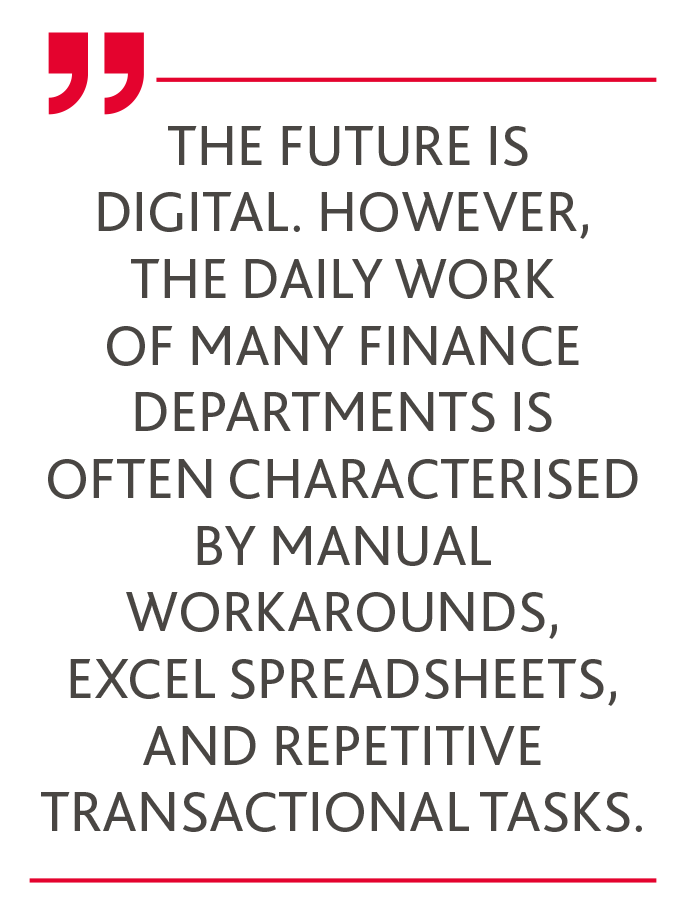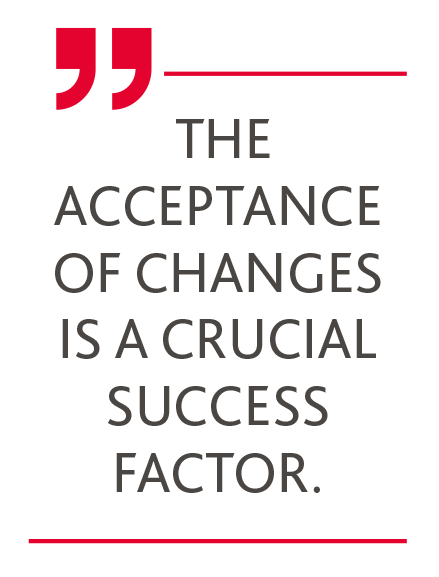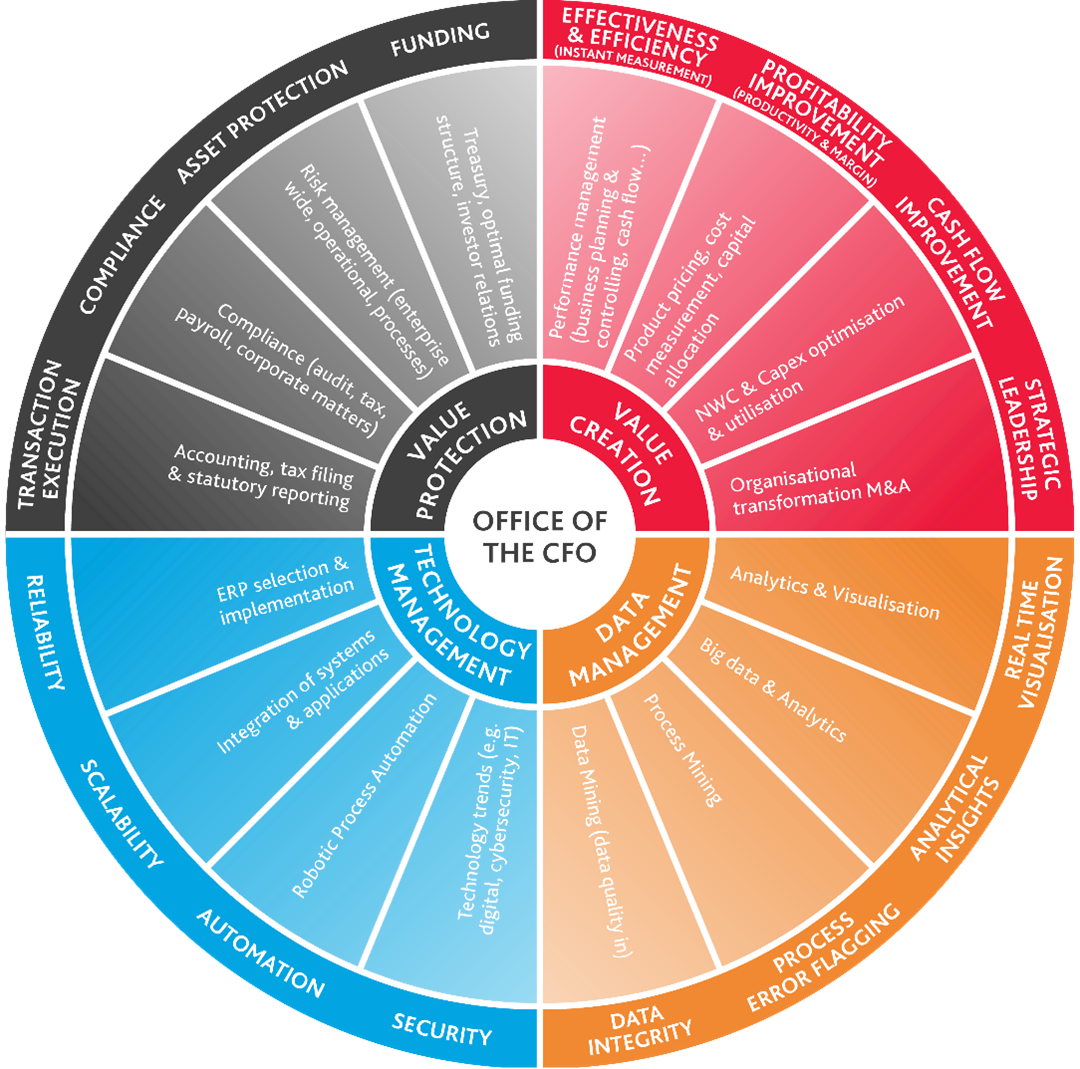Digitisation and AI, the War of Talents, increased cost pressures, extensive regulatory requirements… What else? Business transformations are becoming increasingly complex. This also changes the role of the CFO and the finance organisation as a whole: away from the number and data-focused ‘Business Analyst’ towards a future-oriented Business Architect and Business Partner. CFOs are, more than ever, a significant driver of extensive transformation projects. To provide an impulse on how to shape this important future role, we outline selected key topics at this point.
CFO Agenda – A Cheat Sheet
Before starting the transformation project, it is essential to formulate the financial function’s target image as sharp and focused as possible. What current and future requirements need to be anticipated? An individual CFO agenda must be developed, translated into a guiding strategy, and derived from it, a concrete finance transformation roadmap with the necessary measures. A target operating model tailored to the specific organisation helps consider all relevant transformation dimensions, such as processes, technologies, and personnel, to develop the finance organisation from a business analyst to a strategically acting business partner.
We are currently observing the following key topics that are occupying CFOs:
- New Role Model – CFO as a strategic finance business partner
- Integrated Reporting / Reporting Factory
- Environmental, Social, and Governance (ESG) Reporting
- Predictive Analytics
- Finance Shared Services
- Robotic Process Automation
- New Generation of ERP systems (S4 / HANA, Oracle etc.)
- Dashboarding and Management Information Systems (MIS)
- Digitalisation (planning, consolidation, financial statement preparation)
- Process optimisation
Finance Steering Model
To develop the financial organisation into a strategic business partner, scenario models, stress tests, and methods such as predictive analytics are increasingly important. The recent past, marked by crises and disruptions, has once again demonstrated the importance of future-oriented corporate management. Those who can predict future scenarios accurately, even in an interdisciplinary manner, and think ahead and implement action areas based on this can benefit from a sustainable competitive advantage. Corresponding control models sustainably support this.
However, the question arises: What cross-company, even very specific KPIs, need to be developed, implemented, and displayed in an integrated control cockpit so that top management can make informed decisions based on reliable future scenarios? Of course, issues such as integrated ERP systems, business intelligence, and essential interfaces into operational ERP systems play a crucial role here.
Finance Process Landscape and Target Operating Model
The future is digital. However, our experience shows that the daily work of many finance departments is often characterised by manual workarounds, Excel spreadsheets, and repetitive transactional tasks. To position finance organisations as strategic business partners, these time-consuming manual and error-prone tasks must be minimised, knowledge monopolies dissolved, and processes designed end-to-end - and then actually lived.
 Designing a process and organisational structure in line with these premises is certainly one of the key tasks on the CFO’s agenda. In addition to new ERP functionalities, robotic process automation (RPA) and tool-based workflows can be particularly helpful here. The goal is to significantly increase the digitalisation level of the finance organisation, optimise information flow at the interfaces with operational areas, and further develop the effectiveness and efficiency of the finance community.
Designing a process and organisational structure in line with these premises is certainly one of the key tasks on the CFO’s agenda. In addition to new ERP functionalities, robotic process automation (RPA) and tool-based workflows can be particularly helpful here. The goal is to significantly increase the digitalisation level of the finance organisation, optimise information flow at the interfaces with operational areas, and further develop the effectiveness and efficiency of the finance community.
ERP System Landscape
The ‘digital backbone’ of a finance organisation is the ERP system – whether it be Oracle, Infor, Workday, Microsoft, or, of course, SAP. The options are diverse, and implementation is often time- and cost-intensive. What is the medium- and long-term strategy for your organisation in this area? How can optimal ERP systems be selected, or the existing ERP landscape be further optimised according to individual requirements?
The main goal is to unify heterogeneous data sources in one system, optimise data transparency within the company, and enable CFOs to view decision-relevant data at any time. The ERP system also serves as a basis for increasing the degree of automation of previously manually performed tasks, such as through RPA or the use of various machine learning technologies.
The Transformation Process: Precision Over Force
Over the years, the numerous processes within a company’s finance department have become complex, often relying on the knowledge of a few key resources. The usual steps and procedures are typically carried out under high time pressure, with the new fast-close requirement of ‘ultimo plus 5’ demanded by stakeholders and shareholders. There is significant potential for relief and optimisation in this area. Acceptance of change is a critical factor for success in finance transformation. People and culture are the foundation of continuous and effective transformation. When it comes to these processes, it is essential not to disruptively overhaul them, which can lead to employee resistance.
Furthermore, some processes, especially those leading to bottlenecks, are so intertwined with the company’s specificities that a complete overhaul is not practical, as it risks eroding the company’s entire process landscape. Therefore, we support an evolutionary approach, focusing the finance organisation on a medium-term target image based on complexity-effect relationships, agreeing on specific measures with intermediate goals, and closely monitoring and actively managing progress and impact.
 Through this gradual, gentle transformation, time-critical tasks can be performed quickly by other employees without training time. Other dependent procedures do not need to be restarted. This approach ensures a qualitatively equivalent result while simultaneously increasing speed and reducing costs.
Through this gradual, gentle transformation, time-critical tasks can be performed quickly by other employees without training time. Other dependent procedures do not need to be restarted. This approach ensures a qualitatively equivalent result while simultaneously increasing speed and reducing costs.
HR: Excellence @ Finance
A frequently underestimated component in the context of comprehensive financial transformations lies in the targeted development and motivation of employees. Our experience shows that targeted employee development is one of the success factors for transformations of all kinds. Proven change, training, and communication measures support the transformation efforts and promote the obvious transformation momentum in the organisation. If necessary, training and focused training concepts should also be developed on a qualitative and normative level — preferably in parallel with the development and detailing of the target operating model of the finance organisation. An interdisciplinary approach also helps ensure that employees develop sufficient knowledge and confidence regarding the upcoming changes during the project progress of the transformation project. Viewing transformation as an opportunity rather than a risk is certainly a good guiding principle.

To evaluate whether existing resources and strategies are sufficient to achieve the set goals, BDO has developed the ‘Office of the CFO,’ a central point of contact to provide comprehensive support for finance managers today and in the future.
Conclusion: Finance transformation with sustainable impact
Overall, it can be observed that the role of CFOs and the entire finance department is becoming increasingly important against the backdrop of immense challenges and what we perceive to be a permanent crisis mode for companies. Highly integrated system landscapes, focused reporting, the merging of ESG and financial reporting, and the need for strategy-focused control systems must transform the finance department of all company sizes sustainably. The finance target operating model must be developed further while at the same time accompanying colleagues on this interdisciplinary journey, making them sufficiently ‘Fit for Future’ and actively shaping the transformation.